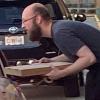UGA Extension Organizes Georgia's First-Ever Pollinator Census
The Locavore

Photo Credit: Becky Griffin
A student at Laurel Springs Elementary School in Decatur counts pollinators.
Georgians paused recently to take a closer look at individual flowering plants to observe and count pollinators visiting their gardens as part of the first census of these tiny creatures that are vital to the food chain.
More than 4,500 Georgia students and gardeners responded to the call for volunteers to count pollinators in their gardens. For 15 minutes, they watched for butterflies, bees and other pollinators that alit on the petals of a single flowering plant. Census takers may have been surprised to be asked to count wasps, flies and moths, but these insects also pollinate certain plants. Early reports show that the amateur entomologists observed more than 133,000 insects.
Becky Griffin, the school and community garden coordinator for the UGA Extension Service, conducted pilot projects for two years to encourage participation among students and gardeners. Griffin modeled the census on the Great Backyard Bird Count, a program run by Cornell University that asks people to count the birds they see in their backyard on a specific winter day.
Griffin reports that “citizen scientists” from the entire state recorded the types of pollinators, the type of plant they observed, the time of day, the weather and the location. The primary goal was to establish a baseline of research about pollinator populations, and to create the first statewide insect census in the nation. Once the researchers crunch the data, they expect to obtain a benchmark that they can use to compare the results of future censuses and observe population trends.
Scientists widely agree that pollinators are under pressure as a result of habitat loss, pollution and insecticides, and conservation groups are taking up the cause to improve their lot. UGA economists found in a 2015 study that these pollinators contribute about $360 million to the state’s economy. Without pollinators, many flowering plants—including food crops—can’t reproduce.
Griffin lights up when talking about the unexpectedly good response to the program, saying she was particularly gratified that so many citizen scientists became involved. “We had a lot of people that planted gardens to attract pollinators with floral resources a year in advance in anticipation of the census,” says Griffin.
“One of our goals of the census was to increase the entomological literacy of our residents, to show people how important insects are in our gardens,” she says. “Raising awareness of the insects is key. People are unaware of the nesting habitats of our native bees, and I hope that people will learn to identify types of bees and how to create new habitat for them. Wasps have a role, too, and are terrific predators of aphids and other pests.”
STEM teacher Diane Parr’s students at Colham Ferry Elementary School in Watkinsville practiced for the census for two weeks and were excited to make history. “The students were wowed by what they witnessed in the garden,” Parr says.
Numerous organizations have responded to the news that pollinator populations are being threatened and have promoted recommendations on their websites. The National Geographic Society, the U.S. Fish and Wildlife Service, the Smithsonian and many other organizations provide online suggestions of ways to increase and diversify pollinator populations. The UGA Extension Service teamed up with the Warnell School of Forestry to publish an illustrated online guide with specific suggestions on how to create a bee habitat.
Griffin says she was amazed at the number of people who submitted their census forms. “I am grateful for all the Georgia citizens who were willing to give up their time to support our pollinators,” she says.
Kris Braman, head of UGA’s Department of Entomology, was also gratified by the response. “When we were talking about the value of the work of our citizen scientists, the educational aspect is as important to me as the baseline data,” she says. “When people sit there for 15 minutes and watch for pollinators, it’s a game-changer in the way they perceive their gardens and the insects that live in those spaces. I think the project was a huge success.”
Both Braman and Griffin said they hope to build on the success of the first census with follow-up counts in the years to come.












comments